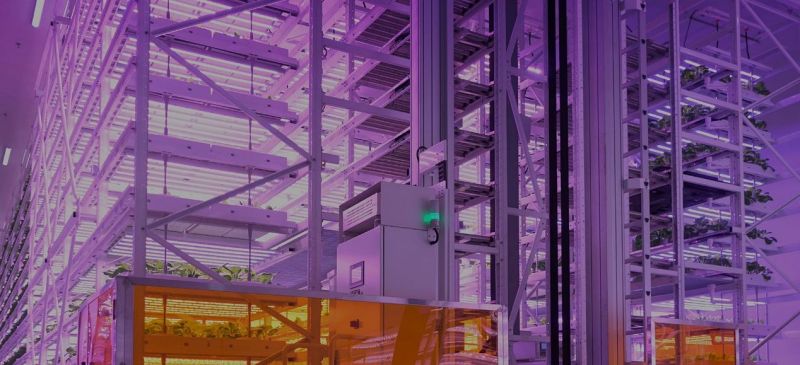Abstract: In recent years, with the continuous exploration of modern agricultural technology, the plant factory industry has also developed rapidly. This paper introduces the status quo, existing problems and development countermeasures of plant factory technology and industry development, and looks forward to the development trend and prospect of plant factories in the future.
1. Current status of technology development in plant factories in China and abroad
1.1 The status quo of foreign technology development
Since the 21st century, the research of plant factories has mainly focused on the improvement of light efficiency, the creation of multi-layer three-dimensional cultivation system equipment, and the research and development of intelligent management and control. In the 21st century, the innovation of agricultural LED light sources has made progress, providing important technical support for the application of LED energy-saving light sources in plant factories. Chiba University in Japan has made a number of innovations in high-efficiency light sources, energy-saving environmental control, and cultivation techniques. Wageningen University in the Netherlands uses crop-environment simulation and dynamic optimization technology to develop an intelligent equipment system for plant factories, which greatly reduces operating costs and significantly improves labor productivity.
In recent years, plant factories have gradually realized the semi-automation of production processes from sowing, seedling raising, transplanting, and harvesting. Japan, the Netherlands, and the United States are at the forefront, with a high degree of mechanization, automation, and intelligence, and are developing in the direction of vertical agriculture and unmanned operation.
1.2 Technology development status in China
1.2.1 Specializd LED light source and energy-saving application technology equipment for artificial light in plant factory
Special red and blue LED light sources for the production of various plant species in plant factories have been developed one after another. The power ranges from 30 to 300 W, and the irradiation light intensity is 80 to 500 μmol/(m2•s), which can provide a light intensity with an appropriate threshold range, light quality parameters, to achieve the effect of high-efficiency energy saving and adapting to the needs of plant growth and lighting. In terms of light source heat dissipation management, the active heat dissipation design of the light source fan has been introduced, which reduces the light decay rate of the light source and ensures the life of the light source. In addition, a method to reduce the heat of LED light source through nutrient solution or water circulation is proposed. In terms of light source space management, according to the evolution law of plant size in the seedling stage and later stage, through the vertical space movement management of LED light source, the plant canopy can be illuminated at close distance and the energy saving goal is achieved. At present, the energy consumption of artificial light plant factory light source can account for 50% to 60% of the total operating energy consumption of the plant factory. Although LED can save 50% energy compared with fluorescent lamps, there is still the potential and necessity of research on energy saving and consumption reduction.
1.2.2 Multi-layer three-dimensional cultivation technology and equipment
The layer gap of the multi-layer three-dimensional cultivation is reduced because the LED replaces the fluorescent lamp, which improves the three-dimensional space utilization efficiency of the plant cultivation. There are many studies on the design of the bottom of the cultivation bed. The raised stripes are designed to generate turbulent flow, which can help plant roots to absorb nutrients in the nutrient solution evenly and increase the concentration of dissolved oxygen. Using the colonization board, there are two colonization methods, that is, the plastic colonization cups of different sizes or the sponge perimeter colonization mode. A slidable cultivation bed system has appeared, and the planting board and the plants on it can be manually pushed from one end to the other, realizing the production mode of planting at one end of the cultivation bed and harvesting at the other end. At present, a variety of three-dimensional multi-layer soilless culture technology and equipment based on nutrient liquid film technology and deep liquid flow technology have been developed, and the technology and equipment for substrate cultivation of strawberries, aerosol cultivation of leafy vegetables and flowers have sprung up. The technology mentioned has developed rapidly.
1.2.3 Nutrient solution circulation technology and equipment
After the nutrient solution has been used for a period of time, it is necessary to add water and mineral elements. Generally, the amount of newly prepared nutrient solution and the amount of acid-base solution are determined by measuring EC and pH. Large particles of sediment or root exfoliation in the nutrient solution need to be removed by a filter. Root exudates in the nutrient solution can be removed by photocatalytic methods to avoid continuous cropping obstacles in hydroponics, but there are certain risks in nutrient availability.
1.2.4 Environmental control technology and equipment
The air cleanliness of the production space is one of the important indicators of the air quality of the plant factory. The air cleanliness (indicators of suspended particles and settled bacteria) in the production space of the plant factory under dynamic conditions should be controlled to a level above 100,000. Material disinfection input, incoming personnel air shower treatment, and fresh air circulation air purification system (air filtration system) are all basic safeguards. The temperature and humidity, CO2 concentration and airflow velocity of the air in the production space are another important content of air quality control. According to reports, setting up equipment such as air mixing boxes, air ducts, air inlets and air outlets can evenly control the temperature and humidity, CO2 concentration and airflow speed in the production space, so as to achieve high spatial uniformity and meet plant needs in different spatial locations. The temperature, humidity and CO2 concentration control system and the fresh air system are organically integrated into the circulating air system. The three systems need to share the air duct, air inlet and air outlet, and provide power through the fan to realize the circulation of air flow, filtration and disinfection, and update and uniformity of air quality. It ensures that the plant production in the plant factory is free of pests and diseases, and no pesticide application is required. At the same time, the uniformity of the temperature, humidity, airflow and CO2 concentration of the growth environment elements in the canopy is guaranteed to meet the needs of plant growth.
2. Development Status of Plant Factory Industry
2.1 Status quo of foreign plant factory industry
In Japan, the research and development and industrialization of artificial light plant factories are relatively fast, and they are at the leading level. In 2010, the Japanese government launched 50 billion yen to support technology research and development and industrial demonstration. Eight institutions including Chiba University and Japan Plant Factory Research Association participated. Japan Future Company undertook and operated the first industrialization demonstration project of a plant factory with a daily output of 3,000 plants. In 2012, the production cost of the plant factory was 700 yen/kg. In 2014, modern factory plant factory in Taga Castle, Miyagi Prefecture was completed, becoming the world’s first LED plant factory with a daily output of 10,000 plants. Since 2016, LED plant factories have entered the fast lane of industrialization in Japan, and break-even or profitable enterprises have emerged one after another. In 2018, large-scale plant factories with a daily production capacity of 50,000 to 100,000 plants appeared one after another, and the global plant factories were developing towards large-scale, professional and intelligent development. At the same time, Tokyo Electric Power, Okinawa Electric Power and other fields began to invest in plant factories. In 2020, the market share of lettuce produced by Japanese plant factories will account for about 10% of the entire lettuce market. Among the more than 250 artificial light-type plant factories currently in operation, 20% are in a loss-making stage, 50% are at the break-even level, and 30% are in a profitable stage, involving cultivated plant species such as lettuce, herbs, and seedlings.
The Netherlands is a real world leader in the field of combined application technology of solar light and artificial light for plant factory, with a high degree of mechanization, automation, intelligence and unmannedness, and has now exported a full set of technologies and equipment as strong products to the Middle East, Africa, China and other countries. American AeroFarms farm is located in Newark, New Jersey, USA, with an area of 6500 m2. It mainly grows vegetables and spices, and the output is about 900 t/year.
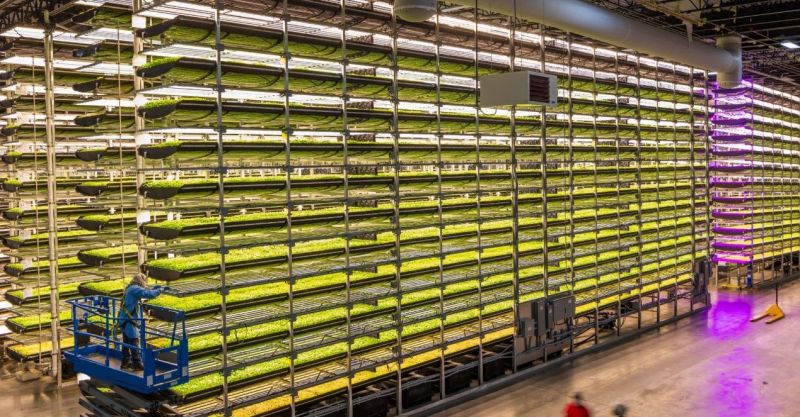 Vertical farming in AeroFarms
Vertical farming in AeroFarms
The vertical farming plant factory of Plenty Company in the United States adopts LED lighting and a vertical planting frame with a height of 6 m. Plants grow from the sides of the planters. Relying on gravity watering, this method of planting does not require additional pumps and is more water-efficient than conventional farming. Plenty claims his farm produces 350 times the output of a conventional farm while using only 1% of the water.
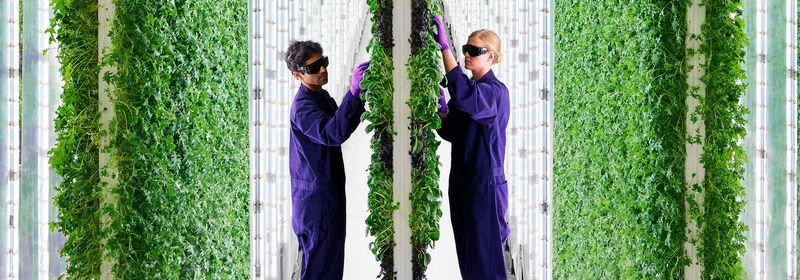 Vertical farming plant factory, Plenty Company
Vertical farming plant factory, Plenty Company
2.2 Status plant factory industry in China
In 2009, the first production plant factory in China with intelligent control as the core was built and put into operation in Changchun Agricultural Expo Park. The building area is 200 m2, and the environmental factors such as temperature, humidity, light, CO2 and nutrient solution concentration of the plant factory can be automatically monitored in real time to realize intelligent management.
In 2010, the Tongzhou Plant Factory built in Beijing. The main structure adopts a single-layer light steel structure with a total construction area of 1289 m2. It is shaped like an aircraft carrier, symbolizing Chinese agriculture taking the lead in setting sail to the most advanced technology of modern agriculture. The automatic equipment for some operations of leafy vegetable production has been developed, which has improved the production automation level and production efficiency of the plant factory. The plant factory adopts a ground source heat pump system and a solar power generation system, which better solves the problem of high operating costs for the plant factory.
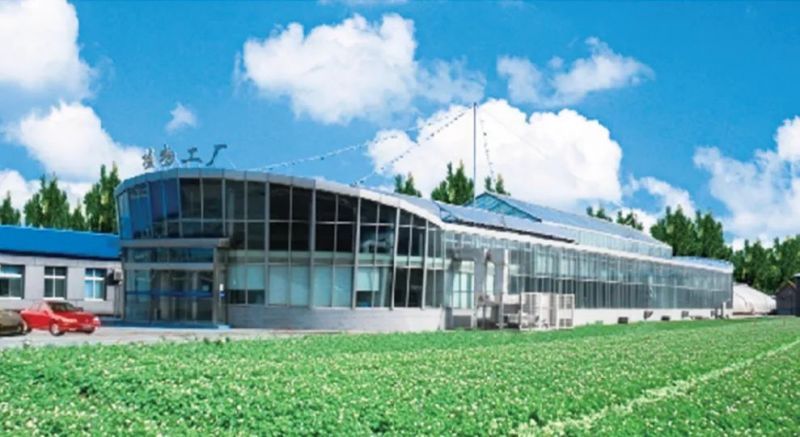
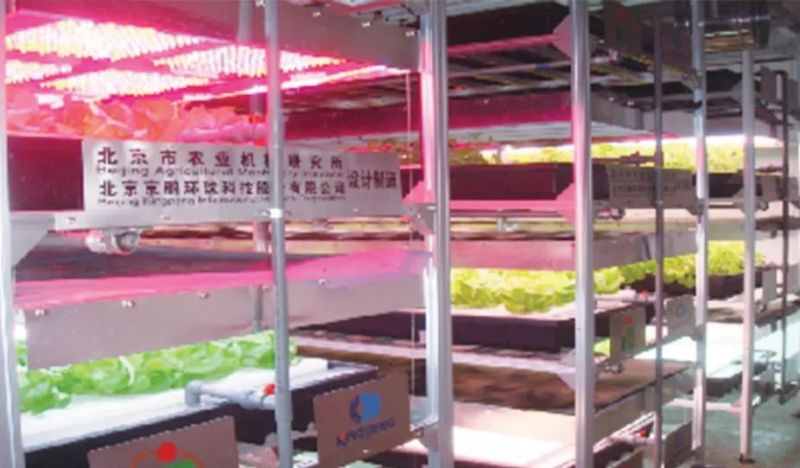 Inside and outside view of Tongzhou Plant Factory
Inside and outside view of Tongzhou Plant Factory
In 2013, many agricultural technology companies was established in Yangling Agricultural High-tech Demonstration Zone, Shaanxi Province. Most of the plant factory projects under construction and operation are located in agricultural high-tech demonstration parks, which are mainly used for popular science demonstrations and leisure sightseeing. Due to their functional limitations, it is difficult for these popular science plant factories to achieve the high yield and high efficiency required by industrialization, and it will be difficult for them to become the mainstream form of industrialization in the future.
In 2015, a major LED chip manufacturer in China cooperated with the Institute of Botany of the Chinese Academy of Sciences to jointly initiate the establishment of a plant factory company. It has crossed from the optoelectronic industry to the “photobiological” industry, and has become a precedent for Chinese LED manufacturers to invest in the construction of plant factories in industrialization. Its Plant Factory is committed to making industrial investment in emerging photobiology, which integrates scientific research, production, demonstration, incubation and other functions, with a registered capital of 100 million yuan. In June 2016, this Plant Factory with a 3-storey building covering an area of 3,000 m2 and a cultivation area of more than 10,000 m2 was completed and put into operation. By May 2017, the daily production scale will be 1,500 kg of leafy vegetables, equivalent to 15,000 lettuce plants per day.
3. Problems and countermeasures facing the development of plant factories
3.1 Problems
3.1.1 High construction cost
Plant factories need to produce crops in a closed environment. Therefore, it is necessary to build supporting projects and equipment including external maintenance structures, air conditioning systems, artificial light sources, multi-layer cultivation systems, nutrient solution circulation, and computer control systems. The construction cost is relatively high.
3.1.2 High operation cost
Most of the light sources required by plant factories come from LED lights, which consume a lot of electricity while providing corresponding spectrums for the growth of different crops. Equipment such as air conditioning, ventilation, and water pumps in the production process of plant factories also consume electricity, so electricity bills are a huge expense. According to statistics, among the production costs of plant factories, electricity costs account for 29%, labor costs account for 26%, fixed asset depreciation accounts for 23%, packaging and transportation account for 12%, and production materials account for 10%.
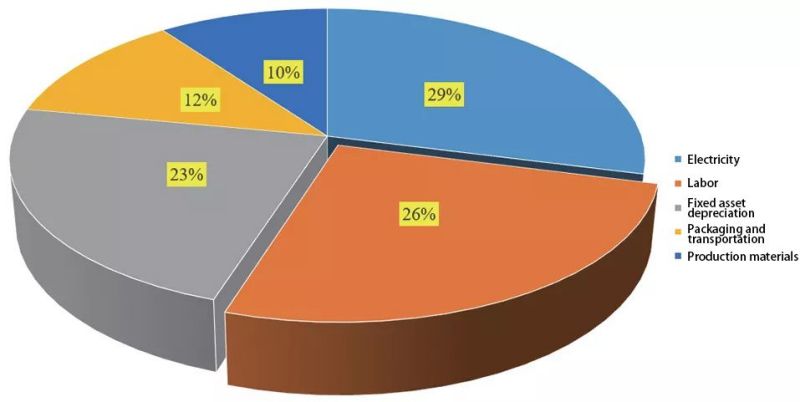 Break-down of production cost for plant factory
Break-down of production cost for plant factory
3.1.3 Low level of automation
The currently applied plant factory has a low level of automation, and processes such as seedling, transplanting, field planting, and harvesting still require manual operations, resulting in high labor costs.
3.1.4 Limited varieties of crops that can be cultivated
At present, the types of crops suitable for plant factories are very limited, mainly green leafy vegetables that grow rapidly, easily accept artificial light sources, and have low canopy. Large-scale planting cannot be carried out for complex planting requirements (such as crops that need to be pollinated, etc.).
3.2 Development Strategy
In view of the problems faced by the plant factory industry, it is necessary to carry out research from various aspects such as technology and operation. In response to the current problems, the countermeasures are as follows.
(1) Strengthen the research on intelligent technology of plant factories and improve the level of intensive and refined management. The development of an intelligent management and control system helps to achieve intensive and refined management of plant factories, which can greatly reduce labor costs and save labor.
(2) Develop intensive and efficient plant factory technical equipment to achieve annual high-quality and high-yield. The development of high-efficiency cultivation facilities and equipment, energy-saving lighting technology and equipment, etc., to improve the intelligent level of plant factories, is conducive to the realization of annual high-efficiency production.
(3) Carry out research on industrial cultivation technology for high value-added plants such as medicinal plants, health care plants, and rare vegetables, increase the types of crops cultivated in plant factories, broaden profit channels, and improve the starting point of profit.
(4) Carry out research on plant factories for household and commercial use, enrich the types of plant factories, and achieve continuous profitability with various functions.
4. Development Trend and Prospect of Plant Factory
4.1 Technology Development Trend
4.1.1 Full-process intellectualization
Based on the machine-art fusion and loss prevention mechanism of the crop-robot system, high-speed flexible and non-destructive planting and harvesting end effectors, distributed multi-dimensional space accurate positioning and multi-modal multi-machine collaborative control methods, and unmanned, efficient and non-destructive sowing in high-rise plant factories -Intelligent robots and supporting equipment such as planting-harvesting-packing should be created, thus realizing the unmanned operation of the whole process.
4.1.2 Make production control smarter
Based on the response mechanism of crop growth and development to light radiation, temperature, humidity, CO2 concentration, nutrient concentration of nutrient solution, and EC, a quantitative model of crop-environment feedback should be constructed. A strategic core model should be established to dynamically analyze leafy vegetable life information and production environment parameters. The online dynamic identification diagnosis and process control system of the environment should also be established. A multi-machine collaborative artificial intelligence decision-making system for the entire production process of a high-volume vertical agricultural factory should be created.
4.1.3 Low carbon production and energy saving
Establishing an energy management system that utilizes renewable energy sources such as solar and wind to complete power transmission and controlling energy consumption to achieve optimal energy management goals. Capturing and reusing CO2 emissions to aid crop production.
4.1.3 High value of premium varieties
Feasible strategies should be taken to breed different high value-added varieties for planting experiments, build a database of cultivation technology experts, conduct research on cultivation technology, density selection, stubble arrangement, variety and equipment adaptability, and form standard cultivation technical specifications.
4.2 Industry development prospects
Plant factories can get rid of the constraints of resources and the environment, realize the industrialized production of agriculture, and attract the new generation of labor force to engage in agricultural production. The key technological innovation and industrialization of China’s plant factories is becoming a world leader. With the accelerated application of LED light source, digitization, automation, and intelligent technologies in the field of plant factories, plant factories will attract more capital investment, talent gathering, and the use of more new energy, new materials, and new equipment. In this way, the in-depth integration of information technology and facilities and equipment can be realized, the intelligent and unmanned level of facilities and equipment can be improved, the continuous reduction of system energy consumption and operating costs through continuous innovation, and the gradual cultivation of specialized markets, intelligent plant factories will usher in golden period of development.
According to market research reports, the global vertical farming market size in 2020 is only US$2.9 billion, and it is expected that by 2025, the global vertical farming market size will reach US$30 billion. In summary, plant factories have broad application prospects and development space.
Author: Zengchan Zhou, Weidong, etc
Citation information: Current Situation and Prospects of Plant Factory Industry Development [J]. Agricultural Engineering Technology, 2022, 42(1): 18-23. by Zengchan Zhou, Wei Dong, Xiugang Li, et al.
Post time: Mar-23-2022


